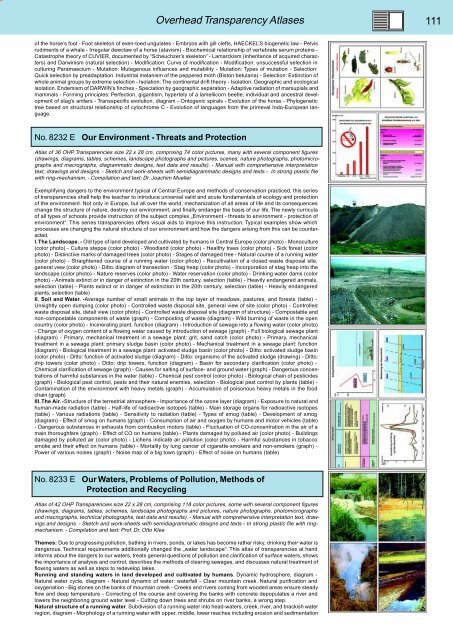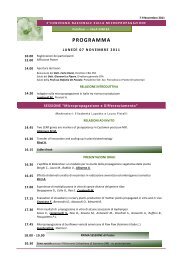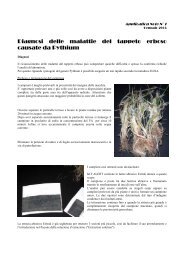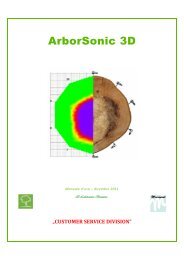BIOLOGY - microscopia.info
BIOLOGY - microscopia.info
BIOLOGY - microscopia.info
You also want an ePaper? Increase the reach of your titles
YUMPU automatically turns print PDFs into web optimized ePapers that Google loves.
Overhead Transparency Atlases<br />
111<br />
of the horse’s foot - Foot skeleton of even-toed ungulates - Embryos with gill clefts, HAECKEL’S biogenetic law - Pelvis<br />
rudiments of a whale - Irregular dewclaw of a horse (atavism) - Biochemical relationship of vertebrate serum proteins -<br />
Catastrophe theory of CUVIER, documented by “Scheuchzer’s skeleton” - Lamarckism (inheritance of acquired characters)<br />
and Darwinism (natural selection) - Modification: Curve of modification - Modification: unsuccessful selection in<br />
culturing Paramaecium - Mutation: Mutagenous influences and mutability - Mutation: Types of mutation - Selection:<br />
Quick selection by preadaptation. Industrial melanism of the peppered moth (Biston betularia) - Selection: Extinction of<br />
whole animal groups by extreme selection - Isolation: The continental drift theory - Isolation: Geographic and ecological<br />
isolation. Endemism of DARWIN’s finches - Speciation by geographic separation - Adaptive radiation of marsupials and<br />
mammals - Forming principles: Perfection, gigantism, hypertely of a lamellicorn beetle, individual and ancestral development<br />
of stag’s antlers - Transspecific evolution, diagram - Ontogenic spirals - Evolution of the horse - Phylogenetic<br />
tree based on structural relationship of cytochrome C - Evolution of languages from the primeval Indo-European language.<br />
No. 8232 E Our Environment - Threats and Protection<br />
Atlas of 36 OHP Transparencies size 22 x 28 cm, comprising 74 color pictures, many with several component figures<br />
(drawings, diagrams, tables, schemes, landscape photographs and pictures, scenes, nature photographs, photomicrographs<br />
and macrographs, diagrammatic designs, test data and results). - Manual with comprehensive interpretation<br />
text, drawings and designs. - Sketch and work-sheets with semidiagrammatic designs and texts - In strong plastic file<br />
with ring-mechanism. - Compilation and text: Dr. Joachim Mueller<br />
Exemplifying dangers to the environment typical of Central Europe and methods of conservation practiced, this series<br />
of transparencies shall help the teacher to introduce universal valid and acute fundamentals of ecology and protection<br />
of the environment. Not only in Europe, but all over the world, mechanization of all areas of life and its consequences<br />
change the structure of nature, destroy our environment, and finally endanger the basis of our life. The newly curricula<br />
of all types of schools provide instruction of the subject complex „Environment - threats to environment - protection of<br />
environment“. This series transparencies offers visual aids to improve this instruction. Typical examples show which<br />
processes are changing the natural structure of our environment and how the dangers arising from this can be counteracted.<br />
I. The Landscape. - Old type of land developed and cultivated by humans in Central Europe (color photo) - Monoculture<br />
(color photo) - Culture steppe (color photo) - Woodland (color photo) - Healthy trees (color photo) - Sick forest (color<br />
photo) - Distinctive marks of damaged trees (color photo) - Stages of damaged tree - Natural course of a running water<br />
(color photo) - Straightened course of a running water (color photo) - Recultivation of a closed waste disposal site,<br />
general view (color photo) - Ditto. diagram of transection - Stag heap (color photo) - Incorporation of stag heap into the<br />
landscape (color photo) - Nature reserves (color photo) - Water reservation (color photo) - Drinking water dams (color<br />
photo) - Animals extinct or in danger of extinction in the 20th century, selection (table) - Heavily endangered animals,<br />
selection (table) - Plants extinct or in danger of extinction in the 20th century, selection (table) - Heavily endangered<br />
plants, selection (table)<br />
II. Soil and Water. -Average number of small animals in the top layer of meadows, pastures, and forests (table) -<br />
Unsightly open dumping (color photo) - Controlled waste disposal site, general view of site (color photo) - Controlled<br />
waste disposal site, detail view (color photo) - Controlled waste disposal site (diagram of structure) - Compostable and<br />
non-compostable components of waste (graph) - Composting of waste (diagram) - Wild burning of waste in the open<br />
country (color photo) - Incinerating plant, function (diagram) - Introduction of sewage into a flowing water (color photo)<br />
- Change of oxygen content of a flowing water caused by introduction of sewage (graph) - Full biological sewage plant<br />
(diagram) - Primary, mechanical treatment in a sewage plant: grit, sand catch (color photo) - Primary, mechanical<br />
treatment in a sewage plant: primary sludge basin (color photo) - Mechanical treatment in a sewage plant: function<br />
(diagram) - Biological treatment in a sewage plant: activated sludge basin (color photo) - Ditto: activated sludge basin<br />
(color photo) - Ditto: function of activated sludge (diagram) - Ditto: organisms of the activated sludge (drawing) - Ditto:<br />
drip towers (color photo) - Ditto: drip towers, function (diagram) - Basin for secondary clarification (color photo) -<br />
Chemical clarification of sewage (graph) - Causes for salting of surface- and ground water (graph) - Dangerous concentrations<br />
of harmful substances in the water (table) - Chemical pest control (color photo) - Biological chain of pesticides<br />
(graph) - Biological pest control, pests and their natural enemies, selection - Biological pest control by plants (table) -<br />
Contamination of the environment with heavy metals (graph) - Accumulation of poisonous heavy metals in the food<br />
chain (graph)<br />
III. The Air. -Structure of the terrestrial atmosphere - Importance of the ozone layer (diagram) - Exposure to natural and<br />
human-made radiation (table) - Half-life of radioactive isotopes (table) - Main storage organs for radioactive isotopes<br />
(table) - Various radiations (table) - Sensitivity to radiation (table) - Types of smog (table) - Development of smog<br />
(diagram) - Effect of smog on humans (graph) - Consumption of air and oxygen by humans and motor vehicles (table)<br />
- Dangerous substances in exhausts from combustion motors (table) - Fluctuation of CO-concentration in the air of a<br />
main thoroughfare (graph) - Effect of CO on humans (table) - Plants damaged by polluted air (color photo) - Buildings<br />
damaged by polluted air (color photo) - Lichens indicate air pollution (color photo) - Harmful substances in tobacco<br />
smoke and their effect on humans (table) - Mortality by lung cancer of cigarette-smokers and non-smokers (graph) -<br />
Power of various noises (graph) - Noise map of a big town (graph) - Effect of noise on humans (table)<br />
No. 8233 E Our Waters, Problems of Pollution, Methods of<br />
Protection and Recycling<br />
Atlas of 42 OHP Transparencies size 22 x 28 cm, comprising 118 color pictures, some with several component figures<br />
(drawings, diagrams, tables, schemes, landscape photographs and pictures, nature photographs, photomicrographs<br />
and macrographs, technical photographs, test data and results). - Manual with comprehensive interpretation text, drawings<br />
and designs. - Sketch and work-sheets with semidiagrammatic designs and texts - In strong plastic file with ringmechanism.<br />
- Compilation and text: Prof. Dr. Otto Klee<br />
Themes: Due to progressing pollution, bathing in rivers, ponds, or lakes has become rather risky, drinking their water is<br />
dangerous. Technical requirements additionally changed the „water landscape“. This atlas of transparencies at hand<br />
<strong>info</strong>rms about the dangers to our waters, treats general questions of pollution and clarification of surface waters, shows<br />
the importance of analysis and control, describes the methods of clearing sewages, and discusses natural treatment of<br />
flowing waters as well as steps to redevelop lakes.<br />
Running and standing waters in land developed and cultivated by humans. Dynamic hydrosphere, diagram -<br />
Natural water cycle, diagram - Natural dynamic of water: waterfall - Clear mountain creek. Natural purification and<br />
oxygenation - Big stones on the banks of mountain creek - Creeks and rivers coming from wooded areas ensure steady<br />
flow and deep temperature - Correcting of the course and covering the banks with concrete depopulates a river and<br />
lowers the neighboring ground water level - Cutting down trees and shrubs on river banks, a wrong step.<br />
Natural structure of a running water. Subdivision of a running water into head-waters, creek, river, and brackish water<br />
region, diagram - Morphology of a running water with upper, middle, lower reaches including erosion and sedimentation







